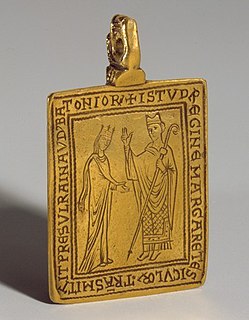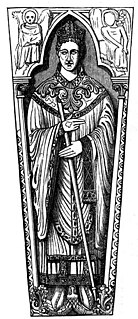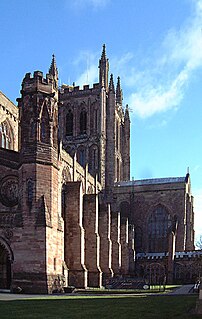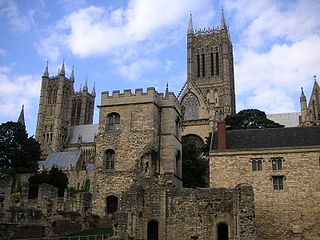Related Research Articles
Ralph d'Escures was a medieval abbot of Séez, bishop of Rochester and then archbishop of Canterbury. He studied at the school at the Abbey of Bec. In 1079 he entered the abbey of St Martin at Séez, and became abbot there in 1091. He was a friend of both Archbishop Anselm of Canterbury and Bishop Gundulf of Rochester, whose see, or bishopric, he took over on Gundulf's death.
Eustace was the twenty-third Lord Chancellor of England, from 1197 to 1198. He was also Dean of Salisbury and Bishop of Ely.
Henry Murdac was abbot of Fountains Abbey and Archbishop of York in medieval England.
William de Wickwane was Archbishop of York, between the years 1279 and 1285.

Reginald fitz Jocelin was a medieval Bishop of Bath and an Archbishop of Canterbury-elect in England. A member of an Anglo-Norman noble family, he was the son of a bishop, and was educated in Italy. He was a household clerk for Thomas Becket, but by 1167 he was serving King Henry II of England. He was also a favourite of King Louis VII of France, who had him appointed abbot of the Abbey of Corbeil. After Reginald angered Becket while attempting to help negotiate a settlement between Becket and the king, Becket called him "that offspring of fornication, that enemy to the peace of the Church, that traitor." When he was elected as a bishop, the election was challenged by King Henry's eldest son, Henry the Young King, and Reginald was forced to go to Rome to be confirmed by Pope Alexander III. He attended the Third Lateran Council in 1179, and spent much of his time administering his diocese. He was elected Archbishop of Canterbury in 1191, but died before he could be installed.
Jocelin of Wells was a medieval Bishop of Bath. He was the brother of Hugh de Wells, who became Bishop of Lincoln. Jocelin became a canon of Wells Cathedral before 1200, and was elected bishop in 1206. During King John of England's dispute with Pope Innocent III, Jocelin at first remained with the king, but after the excommunication of John in late 1209, Jocelin went into exile. He returned to England in 1213, and was mentioned in Magna Carta in 1215.
Savaric fitzGeldewin was an Englishman who became Bishop of Bath and Glastonbury in England. Related to his predecessor as well as to Emperor Henry VI, he was elected bishop on the insistence of his predecessor, who urged his election on the cathedral chapter of Bath. While bishop, Savaric spent many years attempting to annexe Glastonbury Abbey as part of his bishopric. Savaric also worked to secure the release of King Richard I of England from captivity, when the king was held by Emperor Henry VI.
Geoffrey de Burgh was a medieval English cleric who was Archdeacon of Norwich (1200–1225), Bishop of Ely and the brother of William de Burgh and Hubert de Burgh, 1st Earl of Kent.
John of Tours or John de Villula (died 1122) was a medieval Bishop of Wells in England who moved the diocese seat to Bath. He was a native of Tours and was King William I of England's doctor before becoming a bishop. After his consecration as bishop, he was either given or purchased Bath Abbey, a rich monastery, and then moved the headquarters of the diocese from Wells, to the abbey. He rebuilt the church at Bath, building a large cathedral that no longer survives. He gave a large library to his cathedral and received the right to hold a fair in Bath. Not noted for his scholarship, he died suddenly in 1122.

Simon of Apulia was an Italian-born canon lawyer who served as Bishop of Exeter in Devon, England, from 1214 until his death in 1223.
William Langton was a medieval English priest and nephew of Archbishop Walter de Gray. William was selected but never consecrated as Archbishop of York and Bishop of Carlisle.
Walter Mauclerk was a medieval Bishop of Carlisle and Lord High Treasurer of England.
Seffrid I, sometimes known as Seffrid Pelochin, was a medieval Bishop of Chichester.
Ranulf of Wareham was a medieval Bishop of Chichester.
John of Fountains was a medieval Bishop of Ely.

Hugh of Northwold was a medieval Bishop of Ely.

Hugh de Mapenor was a medieval Bishop of Hereford. Although educated and given the title of magister, or "master", the details of his schooling are unknown. Mapenor was a clerk for Giles de Braose, his predecessor as bishop. Later, Mapenor served as Dean of Hereford before being elected as bishop against the wishes of King John of England. During his short episcopate, he supported John's son and successor King Henry III of England, and was active in his diocese, as a number of surviving documents show. He also served as a diplomat for the king.
Robert de Chesney was a medieval English Bishop of Lincoln. He was the brother of an important royal official, William de Chesney, and the uncle of Gilbert Foliot, successively Bishop of Hereford and Bishop of London. Educated at Oxford or Paris, Chesney was Archdeacon of Leicester before his election as bishop in December 1148.

Hugh of Wells was a medieval Bishop of Lincoln. He began his career in the diocese of Bath, where he served two successive bishops, before joining royal service under King John of England. He served in the royal administration until 1209, when he was elected to the see, or bishopric, of Lincoln. When John was excommunicated by Pope Innocent III in November 1209, Hugh went into exile in France, where he remained until 1213.

Ralph Gubion was a native Englishman and abbot of St Albans Abbey from 1146 to 1151.
References
- Doubleday, H. Arthur; Page, William, eds. (1903). A History of the County of Hampshire: Volume 2: Houses of Cistercian Monks: Abbey of Beaulieu. Victoria County History. Retrieved 24 August 2007.
- Fryde, E. B.; Greenway, D. E.; Porter, S.; Roy, I. (1996). Handbook of British Chronology (Third revised ed.). Cambridge, UK: Cambridge University Press. ISBN 0-521-56350-X.
- Greenway, Diana E. (1977). "Carlisle: Bishops". Fasti Ecclesiae Anglicanae 1066–1300. Vol. 2: Monastic Cathedrals (Northern and Southern Provinces). Institute of Historical Research. Archived from the original on 20 October 2013. Retrieved 20 October 2007.
- Knowles, David (1976). The Monastic Order in England: A History of its Development from the Times of St. Dunstan to the Fourth Lateran Council, 940–1216 (Second reprint ed.). Cambridge, UK: Cambridge University Press. ISBN 0-521-05479-6.
- Moorman, John R. H. (1955). Church Life in England in the Thirteenth Century (Revised ed.). Cambridge, UK: Cambridge University Press. OCLC 213820968.